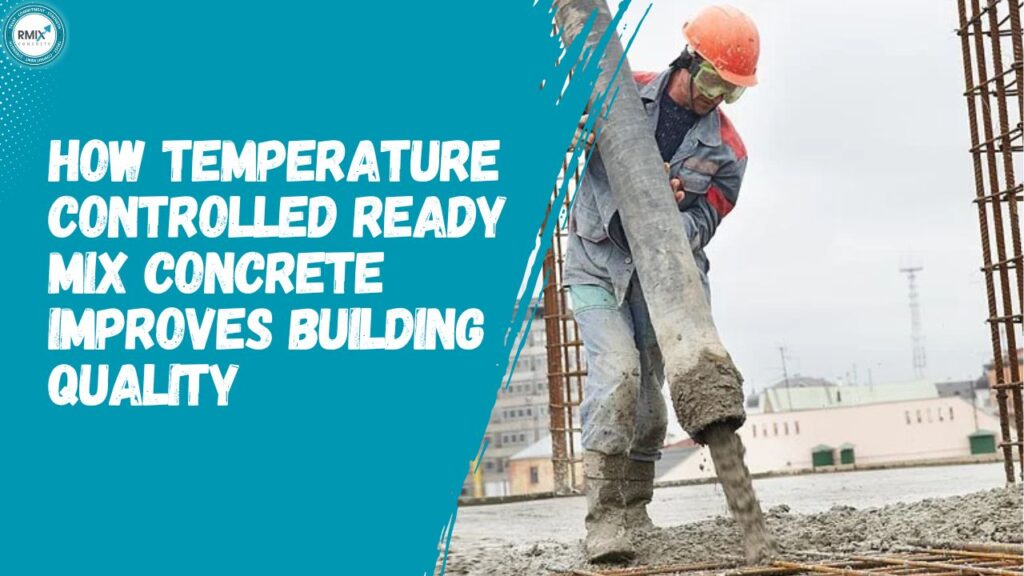
How Temperature Controlled Ready Mix Concrete Improves Building Quality
In modern construction, quality and durability are two factors that can never be compromised. Whether it’s a residential building, a commercial complex, or an infrastructure project, the materials used play a vital role in determining the strength and life of the structure. One such innovation that is transforming the construction industry is Temperature Controlled Ready Mix Concrete (RMC).
By controlling the temperature of concrete during mixing, transportation, and pouring, builders can achieve better results and avoid common issues like cracks, shrinkage, and reduced strength. Let’s understand how temperature-controlled ready mix concrete works and why it is so important for improving building quality.
What is Temperature-Controlled Ready Mix Concrete?
Temperature-controlled ready Mix Concrete is a specially prepared concrete where the temperature is carefully regulated during production and delivery. The ideal concrete temperature usually ranges between 20°C to 30°C, depending on environmental conditions and project requirements.
This control is achieved by using techniques like:
- Chilled water in the mixing process
- Ice flakes added to the mix
- Liquid nitrogen injection for rapid cooling
- Insulated transit mixers to maintain temperature during transportation
By keeping concrete at the right temperature, it sets at a controlled pace, giving better workability, durability, and finish.
Why is Temperature Control in Concrete Important?
Concrete undergoes a chemical reaction called hydration when water is added to cement. This reaction generates heat, which affects how quickly concrete sets and hardens.
If the temperature is too high:
- Concrete sets too fast
- Leads to reduced workability
- Increases the risk of shrinkage cracks
- Can lower long-term strength
If the Temperature is Too Low:
- Setting time becomes too slow
- Risk of incomplete hydration
- May result in weak and porous concrete
Temperature control ensures the concrete cures properly, resulting in stronger and more durable structures.
How Temperature-Controlled Ready Mix Concrete Improves Building Quality
1. Prevents Cracks and Shrinkage
High heat during hydration can cause rapid water evaporation, leading to cracks in the structure. By keeping the temperature in control, concrete sets gradually, reducing the chances of shrinkage and thermal cracks. This improves the aesthetic and structural integrity of the building.
2. Ensures Consistent Strength
Uniform temperature allows the concrete to gain strength steadily over time. This ensures the compressive strength of the concrete is as per design specifications, leading to safer and longer-lasting buildings.
3. Better Workability
Controlled temperature gives more working time for placing, compaction, and finishing. This is especially important in large-scale projects where concrete needs to be poured and finished over extended hours.
4. Increases Durability in Harsh Weather
Temperature-controlled concrete performs better in extreme climates—whether hot, cold, or humid. It reduces damage caused by thermal expansion, contraction, and freeze-thaw cycles, making the structure more durable.
5. Improves Bonding and Surface Finish
By slowing down the setting process, temperature-controlled concrete allows proper bonding between cement particles and aggregates. This results in a smoother surface finish and better adhesion for paints, tiles, and other finishing materials.
6. Minimizes Structural Defects
Proper curing temperature reduces voids and weak zones in concrete. This leads to fewer structural defects, ensuring that the building meets high safety and quality standards.
Applications of Temperature-Controlled Ready Mix Concrete
This technology is widely used in projects where precision and durability are essential:
- High-rise Buildings – where uniform strength is crucial
- Bridges and Flyovers – to handle heavy loads and environmental stress
- Industrial Floors – for high wear resistance
- Dams and Water Tanks – where water tightness is important
- Airports and Highways – for withstanding traffic and temperature variations
Best Practices for Using Temperature Controlled Ready Mix Concrete
To get the most out of this advanced concrete solution, builders should follow these guidelines:
- Plan According to Climate – Understand the local weather and choose the right temperature control method.
- Use High-Quality Materials – Good quality cement, aggregates, and water enhance performance.
- Monitor Temperature Continuously – Use thermometers or sensors during transportation and placement.
- Avoid Delays in Pouring – Even with temperature control, concrete should be poured without unnecessary delays.
- Proper Curing – Maintain moisture and temperature during curing to maximize strength.
Advantages of Temperature Controlled Ready Mix Concrete
- Better quality and durability of structures
- Reduces cracks and other defects
- Improved performance in extreme climates
- Time-efficient for large projects
- Cost-effective in the long run due to reduced maintenance
Environmental Benefits
Temperature-controlled ready mix concrete also supports sustainable construction. By minimizing defects and extending the lifespan of buildings, it reduces the need for repairs and reconstruction, leading to lower carbon emissions and material wastage.
Conclusion
Temperature controlled ready mix concrete is a game-changer in the construction industry. By ensuring that concrete sets and cures at the ideal temperature, it improves strength, durability, workability, and finish all of which contribute to better building quality.
In an era where infrastructure needs to be stronger and last longer, adopting such advanced materials is not just a choice but a necessity. Whether you’re building a home, a bridge, or a commercial tower, temperature-controlled RMC ensures your structure stands the test of time.
FAQs
1. What is Temperature Controlled Ready Mix Concrete?
Temperature Controlled Ready Mix Concrete is concrete produced and delivered while maintaining an ideal temperature, ensuring better workability, strength, and durability in construction.
2. Why is Temperature Control Important in Concrete?
Temperature control ensures proper hydration, prevents cracks, and improves the long-term strength of the structure by avoiding premature setting or delayed curing.
3. What is the ideal Temperature for Ready Mix Concrete?
The ideal temperature range is usually between 20°C to 30°C, but it may vary depending on the project requirements and environmental conditions.
4. How is the Temperature of Ready Mix Concrete Controlled?
Builders use chilled water, ice flakes, liquid nitrogen, and insulated transit mixers to maintain the desired concrete temperature during mixing and transportation.
5. What Happens if Concrete Gets Too Hot During Mixing?
If concrete gets too hot, it sets too quickly, which can cause shrinkage cracks, reduced strength, and poor finishing quality.
6. Can Temperature Controlled Ready Mix Concrete Be Used in Cold Weather?
Yes, in cold weather, temperature control ensures the concrete doesn’t freeze and cures properly, achieving the required strength and durability.
7. Where is Temperature Controlled RMC Commonly Used?
It is used in high-rise buildings, bridges, industrial floors, dams, water tanks, airports, and any structure requiring high strength and durability.
8. Does Temperature Controlled RMC Cost more than Normal RMC?
It may cost slightly more due to the temperature regulation process, but it saves money in the long run by reducing maintenance and repair costs.
9. How Does Temperature Controlled Concrete Improve Building Quality?
It prevents cracks, ensures consistent strength, improves workability, and enhances the lifespan of the structure, resulting in better overall quality.
10. Is Temperature Controlled Ready Mix Concrete Eco-Friendly?
Yes, by reducing structural defects and extending the life of buildings, it minimizes material wastage and supports sustainable construction practices.












